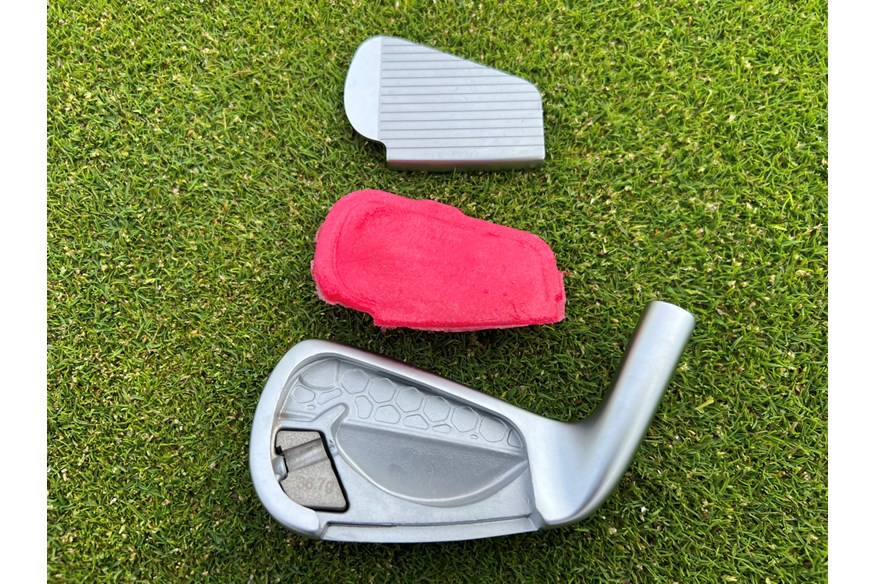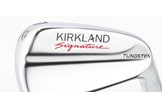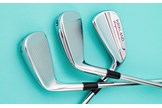Can the £485 Kirkland Signature irons ever be a credible alternative to the mighty TaylorMade P790?
Last updated:
Kirkland’s first hollow body players’ distance iron has the look of a TaylorMade P790, but Costco’s offering serves up a 60% saving over the market leader. My head-to-head test will help you decide whether the Kirklands are as good a buy as they seem.
Since launching in December 2023 Costco’s Kirkland Signature irons have caused a heck of a stir. Like the company’s urethane-covered ball that targeted the market-leading Titleist Pro V1 the Kirkland Signature takes aim at one of the best irons of the last decade – the TaylorMade P790.
The brains behind Kirkland know their strategy of producing lower priced but cosmetically similar alternatives to some of the most respected golf products out there works, as alongside golf balls they’ve poked their fingers into the pies of CNC Milled putters and performance wedges that offer substantial cost savings over similar looking Scotty Cameron and Vokey Design offerings. With the wind in their sails, it’s not surprising the company is now looking to conquer the best players’ distance iron market.

Within hours of launch at the back end of last year, the Signature irons had sold out. Costco were quickly hit with a ‘Cease and Desist’ legal letter from TaylorMade plus a lawsuit followed for multiple patent infringements against their P790. There’s also been accusations of Costco falsely advertising how the irons are made, whether any part of the iron is forged, and if an injected urethane insert actually resides inside.
Almost a year on from launch the Kirkland Signature irons are sporadically available at Costco outlets in the UK, so with substantial savings on offer we wanted to find out once and for all whether this super keenly priced iron truly represents a sound investment.
How we tested the irons
Before putting both irons in the hands of TG Test Pro Neil Wain we created an indoor test lab at Keele Golf Centre to ensure a controlled environment, which meant we could use premium Titleist Pro V1x golf balls and a Foresight GC Quad launch monitor to create the most reliable data possible.
We rejected major misses but recorded how shots launched, span, peaked out, and how far they flew in which direction.
See more about how we test golf equipment here.

My Kirkland Signature Iron Review
The Kirkland Signature iron is a Players’ Distance model designed to go head-to-head against the P790, Costco says it’s for golfers with a handicap between 5 – 20. Rumour has it a former TaylorMade engineer who worked on the original P790 moved to the design company responsible for producing the model for Costco hence why TaylorMade is keen to protect their intellectual property.
It’s hard to definitively know whether anything about the model is actually forged. While the company’s website doesn’t have the word ‘forged’ anywhere on the Kirkland Signature irons page the hosel of each iron is stamped with ‘Forged’ and the box our set arrived in made reference to the faces being forged.
If you’re unfamiliar with where the Kirkland Signature iron sits it would make a lot of sense to see it as a cheaper rival to the Callaway Apex Ai200, Titleist T200, Ping i530, and PXG 0311 GEN7 P.


| Stock Shaft | True Temper Elevate 115 |
| Stock Grip | Lamkin Crossline |
| 7-Iron Loft | 31° |
| Category | Players' Distance Iron |
| Forgiveness rating | 2.5/5 |
Shape, profile, looks: 5/10
One of the massive draws of the P790 over the years has been that aspirational golfers get a great-looking iron that’s super powerful and pretty forgiving, unfortunately, the Kirkland just isn’t in the same league. Expect an awkward profile with a prominent topline width and a very sharp transition into the toe, a shape that drew the eye of TG Test Pro Neil Wain.
Compared to the P790 the sole is also very curved and rounded, while that’s not necessarily a bad thing when playing from uneven ground, the feature is much less attractive to the eye and thanks to the super shiny polished finish I reckon there’s more than a whiff of game improver about this model.

Feel and feedback: 8/10
Whether there is an injected urethane insert inside or not, or if the heads do or don’t have forged faces TG Test Pro Neil Wain thought the feedback and sound was different between the two models but also hard to truly differentiate. That’s a good sign if you’re seriously considering buying a set, as if our test pro struggled to feel or hear too much difference it’s highly likely you will too.
While the Kirkland enjoys blurring the differences between itself and the P790 there’s no escaping this model doesn’t have a speed pocket through the sole, a technology that TaylorMade believes is good at protecting ball speeds when shots impact low on the face.
Data, data, data: 6/10
I’ve heard iron designers and engineers spout many times that modern irons need stronger lofts to optimize launch, spin, peak height and distance as the tech wrapped up in their heads is so efficient. Never before though have I seen such conclusive evidence to back up their thinking.
Our test data shows from a very slightly weaker loft that the Kirkland iron gave up 2.9 mph of ball speed which we’d sort of expect although not to such a great extent. The head’s efficiency is not in the same league as the P790 as it also launched lower, flew lower, and hit the green at a shallower angle, which wouldn’t typically be the case for an iron with more loft.
At our test pros speed that meant giving up 7 yards of carry distance with a 7-iron which obviously is substantial.
Tech and components: 5/10
The Kirkland comes with a recognized True Temper Elevate shaft and respected Lamkin Crossline grip – a real bonus considering the sub £500 price tag. The Elevate is a high launch, high spin option that is designed to get shots to a good peak height, just be aware the 115 model is 10g heavier than the shaft in the P790 which could be cause for concern if your swing speed hovers just above average.
While the components are half decent if the shaft doesn’t fit you, or your game dictates needing anything other than a regular or stiff flex shaft at standard spec Kirkland really can’t help, there’s zero fitting options here.

Overall verdict: 24/40
Copycat golf products are absolutely nothing new, whenever there’s a hot new trend or product there’s always a company waiting in the wings to create similar-looking designs and sell them for less, giving consumers choices based on budget. I’m ok, with that so long as you never pass off a product as performing in the same way.
To my mind, Costco has gone out of it’s way to create a product that could be confused for offering the same performance as a P790. There’s confusion around whether any part of the head is forged, there’s no speed pocket in the sole and as our data spells out shots don’t launch higher with less spin as is typically the case with modern thin fast-face irons. Which begs the question is the face thin enough to flex at all? If the answer is no, then any filler inside, if there is one, must be playing a very small role in performance as TaylorMade and PXG (with the 0311 GEN6 P) insist their lightweight iron cores play significant roles in supporting the face and avoiding failures.
Golfers could easily buy this product and expect the same performance as a P790, it’s what Costco has gone out of its way to allude to, even as far as producing an almost identical graphic to TaylorMade’s original P790 to show the technology inside on their website.
If you’re buying this product and expect P790 levels of performance – don’t! However, if £500 is your absolute limit for a new set of irons that will get you out on the golf course and playing the game to reasonable levels (with what is essentially one-piece iron levels of performance) absolutely the Kirkland Signature can do a job for you. I can’t think of truer words to say about this market disruptor than ‘you only get what you pay for’.
The test data
| Iron | Loft | Ball Speed | Launch Angle | Backspin | Height | Descent Angle | Carry Distance |
| Kirkland Signature | 7i – 31˚ | 125.2 MPH | 16.3˚ | 5732 RPM | 33 YDS | 45.7˚ | 183 YDS |
| TaylorMade P790 (2023) | 7I – 30.5˚ | 128.1 MPH | 16.9˚ | 5392 RPM | 36 YDS | 46.7˚ | 190 YDS |
My TaylorMade P790 (2023) Iron Review
The P790 has utterly changed TaylorMade’s iron business since its launch in 2017. This hollow body players’ distance iron targets golfers with handicaps less than 14, but over the franchise’s lifetime P790s have fallen into the hands of golfers playing off +4 – 24 handicaps.
A modern hollow body fast-face design means weight is positioned efficiently around the head with lightweight Speed Foam injected to support the face and maximize energy transfer at impact. The P790 has been TaylorMade’s largest-selling forged iron ever (only the face is forged), expect to see a revised 5th generation appearing early in 2025.


| Stock Shaft | True Temper Dynamic Gold 105/95 |
| Stock Grip | Golf Pride Z Grip 360 |
| 7-Iron Loft | 30.5° |
| Category | Players' Distance Iron |
| Forgiveness Rating | 2.5/5 |
Shape, profile, looks: 9/10
A decade ago players’ distance irons had barely arrived on the scene, back in 2014 it was the forged but strong lofted Callaway Apex that originally sparked the trend, instantly seeing success. By serving up the looks of the best players’ irons with slightly more forgiveness, playability, and stronger lofts in a forged head, it meant there was no longer a giant-sized leap moving from the best game improver irons to the players’ iron arena.
Models like the P790 have really attractive head shapes and profiles that seduce golfers into wanting models in this category, hence why they consistently produce such strong sales. The P790 still dines out on being aspirational for many mid-handicap club golfers, the heads are beautifully designed, they inspire confidence at address, and look great in the bag. For me, you’ll struggle to find a better combination in the category.

Feel and feedback: 9/10
The P790s are not a solid one-piece forged head like the TaylorMade P7CB so it would be unfair to expect the pair to sound and feel the same, yet our test pro in any blind test would have a tough time identifying which is which based purely on subjectives.
In this test both irons were tough to differentiate between, I’ve scored the P790 one point higher because we know what’s inside and what the tech is doing in terms of performance. Having been a golf club designer I understand how easy it is to overlook the complicated structures employed inside the P790 to create a progressive center of gravity through the set, a feature that isn’t present in the Kirkland.
It’s only when you get out on the golf course that you understand attention to details like this up consistency and predictability through the bag, which over the course of a season will aid your scoring potential.

Data, data, data: 10/10
We’ve tested every generation of the TaylorMade P790 multiple times here at TG and each has performed admirably against the stiffest of competition in the players’ distance iron category, hence why rivals want it knocked from its pedestal and Costco has a desire to produce a lower priced alternative.
Just like its ancestors the 2023 P790s numbers speak for themselves. While many will justify a decision to buy the Kirkland Signatures by writing off our ball speed gains and 7 yard carry distance difference by thinking ‘they will be more closely matched at my speed’ you cannot afford to write off how shots got to their destination.
Where the P790 will perform much more like others in the players’ iron category with higher launch, slightly less spin (which adds distance), and a steeper descent angle, the Kirkland is much more likely to replicate the numbers from a solid piece iron like the Srixon ZX7, Mizuno Pro 243 or Titleist T150, which at lesser speeds will make them less playable.

Tech and components: 10/10
Cut the P790s in half and you’ll see the internal construction is very different for each iron which ensures optimisation across the set. Over four generations TaylorMade have worked on and developed the P790 to the point where it is now the most technologically advanced and challenging iron the brand makes. All that learning offers golfers incremental gains in performance, which are well worth having stacked in your favor when it comes to hitting approach shots closer more often.
The stock Dynamic Gold 105 shafts are proven performers and I love how the weight drops to 95 in the regular flex, it’s a move that opens the P790 up to slightly more average-speed players. Unlike the Kirkland you can customize loft, length, lie, swingweight as well as having a myriad of shaft and grip choices, and because TaylorMade wants to be known as a fitting company they also actively encourage you to get fitted and tailor a set to your exact spec.
Overall verdict: 38/40
There might be a market for a lower-priced P790 but much like how the Kirkland Signature V3 golf ball doesn’t beat the Titleist Pro V1 Costco’s iron offering doesn’t beat the P790. Our test data spells out everything you need to know about the P790’s superiority, yet of course I understand not everyone has the means to spend £1200 or more on a new set of irons.
If I were spending my own money and found myself considering the Kirkland I’d be inclined to have a look at the best used iron deals to see how much a set of secondhand P790s would cost. Personally, I don’t like the uncertainty of not knowing exactly what’s inside the Kirklands or how they’re made, whereas any major brand would happily disclose this information, so you can make an informed buying decision.
At the end of the day, no golfer is going to say they’d rather have a set of Kirkland Signature irons in their bag instead of the P790s, if you do plump for the cost savings of Costco’s model you will play a budget quality set of irons. However, where lots of golfers have forked out for sets of P790s since their launch in 2017 and have looked after them and cherished them for 5, 8, or even 10 years, I doubt whether in a decade many serious golfers will believe the Kirkland’s were their best ever investment.




